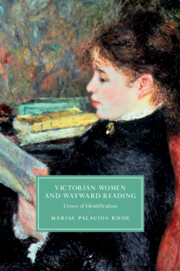Book contents
- Victorian Women and Wayward Reading
- Cambridge Studies in Nineteenth-Century Literature and Culture
- Victorian Women and Wayward Reading
- Copyright page
- Dedication
- Contents
- Figures
- Acknowledgments
- Introduction
- Chapter 1 Masculine Identification and Marital Dissolution
- Chapter 2 Novels without Heroines: Sensation and Elective Identification
- Chapter 3 Character Invasion and the Victorian Actress
- Chapter 4 Antipathetic Telepathy: Female Mediums and Reading the Enemy
- Chapter 5 “The Valley of the Shadow of Books”: The Morbidity of Female Detachment
- Chapter 6 The New Crisis: Can We Teach Identification?
- Notes
- Works Cited
- Index
- Cambridge Studies in Nineteenth-Century Literature and Culture
Chapter 1 - Masculine Identification and Marital Dissolution
Published online by Cambridge University Press: 30 October 2020
- Victorian Women and Wayward Reading
- Cambridge Studies in Nineteenth-Century Literature and Culture
- Victorian Women and Wayward Reading
- Copyright page
- Dedication
- Contents
- Figures
- Acknowledgments
- Introduction
- Chapter 1 Masculine Identification and Marital Dissolution
- Chapter 2 Novels without Heroines: Sensation and Elective Identification
- Chapter 3 Character Invasion and the Victorian Actress
- Chapter 4 Antipathetic Telepathy: Female Mediums and Reading the Enemy
- Chapter 5 “The Valley of the Shadow of Books”: The Morbidity of Female Detachment
- Chapter 6 The New Crisis: Can We Teach Identification?
- Notes
- Works Cited
- Index
- Cambridge Studies in Nineteenth-Century Literature and Culture
Summary
Victorian culture encouraged the identification of women readers with male narrators and characters as a vehicle for female submission to male representation through marriage. This chapter argues that wayward women readers were not appeased by masculine identification, but rather inspired by it to act beyond the domestic sphere. In contrast with women authors such as Elizabeth Barrett Browning, Charlotte Brontë, and George Eliot, who were criticized for adopting conventionally masculine styles or subject matter, women readers were exhorted from girlhood in conduct guides and John Ruskin’s Sesame and Lilies lectures to prepare for absorption into their husbands’ legal identities through identification with male characters and activities. Written during the debates on the reform of marriage law that would continue through the end of the century, and published on the eve of the 1857 Matrimonial Causes Act, Barrett Browning’s Aurora Leigh promotes a distinctively literary rather than marital mode of identification with masculinity. Instead of identifying herself with her future husband, an action she associates with self-erasure, Aurora models a wayward identification with male poetic muses that allows her to maintain her integrity as an artistic subject.
Keywords
- Type
- Chapter
- Information
- Victorian Women and Wayward ReadingCrises of Identification, pp. 23 - 48Publisher: Cambridge University PressPrint publication year: 2020



